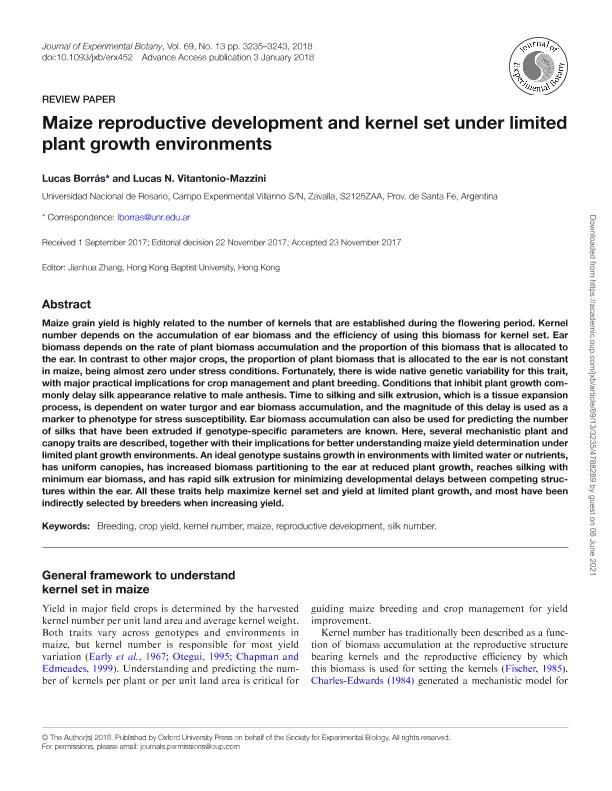Mostrar el registro sencillo del ítem
dc.contributor.author
Borras, Lucas

dc.contributor.author
Vitantonio Mazzini, Lucas Nicolás

dc.date.available
2023-01-27T10:55:51Z
dc.date.issued
2018-06
dc.identifier.citation
Borras, Lucas; Vitantonio Mazzini, Lucas Nicolás; Maize reproductive development and kernel set under limited plant growth environments; Oxford University Press; Journal of Experimental Botany; 69; 13; 6-2018; 3235-3243
dc.identifier.issn
0022-0957
dc.identifier.uri
http://hdl.handle.net/11336/185861
dc.description.abstract
Maize grain yield is highly related to the number of kernels that are established during the flowering period. Kernel number depends on the accumulation of ear biomass and the efficiency of using this biomass for kernel set. Ear biomass depends on the rate of plant biomass accumulation and the proportion of this biomass that is allocated to the ear. In contrast to other major crops, the proportion of plant biomass that is allocated to the ear is not constant in maize, being almost zero under stress conditions. Fortunately, there is wide native genetic variability for this trait, with major practical implications for crop management and plant breeding. Conditions that inhibit plant growth commonly delay silk appearance relative to male anthesis. Time to silking and silk extrusion, which is a tissue expansion process, is dependent on water turgor and ear biomass accumulation, and the magnitude of this delay is used as a marker to phenotype for stress susceptibility. Ear biomass accumulation can also be used for predicting the number of silks that have been extruded if genotype-specific parameters are known. Here, several mechanistic plant and canopy traits are described, together with their implications for better understanding maize yield determination under limited plant growth environments. An ideal genotype sustains growth in environments with limited water or nutrients, has uniform canopies, has increased biomass partitioning to the ear at reduced plant growth, reaches silking with minimum ear biomass, and has rapid silk extrusion for minimizing developmental delays between competing structures within the ear. All these traits help maximize kernel set and yield at limited plant growth, and most have been indirectly selected by breeders when increasing yield.
dc.format
application/pdf
dc.language.iso
eng
dc.publisher
Oxford University Press

dc.rights
info:eu-repo/semantics/openAccess
dc.rights.uri
https://creativecommons.org/licenses/by-nc-sa/2.5/ar/
dc.subject
BREEDING
dc.subject
CROP YIELD
dc.subject
KERNEL NUMBER
dc.subject
MAIZE
dc.subject
REPRODUCTIVE DEVELOPMENT
dc.subject
SILK NUMBER
dc.subject.classification
Agricultura

dc.subject.classification
Agricultura, Silvicultura y Pesca

dc.subject.classification
CIENCIAS AGRÍCOLAS

dc.title
Maize reproductive development and kernel set under limited plant growth environments
dc.type
info:eu-repo/semantics/article
dc.type
info:ar-repo/semantics/artículo
dc.type
info:eu-repo/semantics/publishedVersion
dc.date.updated
2023-01-26T17:27:09Z
dc.journal.volume
69
dc.journal.number
13
dc.journal.pagination
3235-3243
dc.journal.pais
Reino Unido

dc.journal.ciudad
Oxford
dc.description.fil
Fil: Borras, Lucas. Consejo Nacional de Investigaciones Científicas y Técnicas. Centro Científico Tecnológico Conicet - Rosario. Instituto de Investigaciones en Ciencias Agrarias de Rosario. Universidad Nacional de Rosario. Facultad de Ciencias Agrarias. Instituto de Investigaciones en Ciencias Agrarias de Rosario; Argentina
dc.description.fil
Fil: Vitantonio Mazzini, Lucas Nicolás. Consejo Nacional de Investigaciones Científicas y Técnicas. Centro Científico Tecnológico Conicet - Rosario. Instituto de Investigaciones en Ciencias Agrarias de Rosario. Universidad Nacional de Rosario. Facultad de Ciencias Agrarias. Instituto de Investigaciones en Ciencias Agrarias de Rosario; Argentina
dc.journal.title
Journal of Experimental Botany

dc.relation.alternativeid
info:eu-repo/semantics/altIdentifier/doi/http://dx.doi.org/10.1093/jxb/erx452
Archivos asociados
